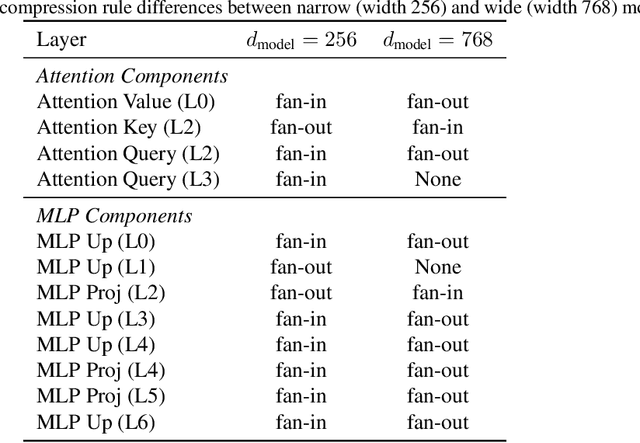Dayal Singh Kalra
When Can You Get Away with Low Memory Adam?
Mar 03, 2025



Abstract:Adam is the go-to optimizer for training modern machine learning models, but it requires additional memory to maintain the moving averages of the gradients and their squares. While various low-memory optimizers have been proposed that sometimes match the performance of Adam, their lack of reliability has left Adam as the default choice. In this work, we apply a simple layer-wise Signal-to-Noise Ratio (SNR) analysis to quantify when second-moment tensors can be effectively replaced by their means across different dimensions. Our SNR analysis reveals how architecture, training hyperparameters, and dataset properties impact compressibility along Adam's trajectory, naturally leading to $\textit{SlimAdam}$, a memory-efficient Adam variant. $\textit{SlimAdam}$ compresses the second moments along dimensions with high SNR when feasible, and leaves when compression would be detrimental. Through experiments across a diverse set of architectures and training scenarios, we show that $\textit{SlimAdam}$ matches Adam's performance and stability while saving up to $98\%$ of total second moments. Code for $\textit{SlimAdam}$ is available at https://github.com/dayal-kalra/low-memory-adam.
Why Warmup the Learning Rate? Underlying Mechanisms and Improvements
Jun 13, 2024Abstract:It is common in deep learning to warm up the learning rate $\eta$, often by a linear schedule between $\eta_{\text{init}} = 0$ and a predetermined target $\eta_{\text{trgt}}$. In this paper, we show through systematic experiments using SGD and Adam that the overwhelming benefit of warmup arises from allowing the network to tolerate larger $\eta_{\text{trgt}}$ by forcing the network to more well-conditioned areas of the loss landscape. The ability to handle larger $\eta_{\text{trgt}}$ makes hyperparameter tuning more robust while improving the final performance. We uncover different regimes of operation during the warmup period, depending on whether training starts off in a progressive sharpening or sharpness reduction phase, which in turn depends on the initialization and parameterization. Using these insights, we show how $\eta_{\text{init}}$ can be properly chosen by utilizing the loss catapult mechanism, which saves on the number of warmup steps, in some cases completely eliminating the need for warmup. We also suggest an initialization for the variance in Adam which provides benefits similar to warmup.
Universal Sharpness Dynamics in Neural Network Training: Fixed Point Analysis, Edge of Stability, and Route to Chaos
Nov 03, 2023Abstract:In gradient descent dynamics of neural networks, the top eigenvalue of the Hessian of the loss (sharpness) displays a variety of robust phenomena throughout training. This includes early time regimes where the sharpness may decrease during early periods of training (sharpness reduction), and later time behavior such as progressive sharpening and edge of stability. We demonstrate that a simple $2$-layer linear network (UV model) trained on a single training example exhibits all of the essential sharpness phenomenology observed in real-world scenarios. By analyzing the structure of dynamical fixed points in function space and the vector field of function updates, we uncover the underlying mechanisms behind these sharpness trends. Our analysis reveals (i) the mechanism behind early sharpness reduction and progressive sharpening, (ii) the required conditions for edge of stability, and (iii) a period-doubling route to chaos on the edge of stability manifold as learning rate is increased. Finally, we demonstrate that various predictions from this simplified model generalize to real-world scenarios and discuss its limitations.
Phase diagram of training dynamics in deep neural networks: effect of learning rate, depth, and width
Feb 23, 2023Abstract:We systematically analyze optimization dynamics in deep neural networks (DNNs) trained with stochastic gradient descent (SGD) over long time scales and study the effect of learning rate, depth, and width of the neural network. By analyzing the maximum eigenvalue $\lambda^H_t$ of the Hessian of the loss, which is a measure of sharpness of the loss landscape, we find that the dynamics can show four distinct regimes: (i) an early time transient regime, (ii) an intermediate saturation regime, (iii) a progressive sharpening regime, and finally (iv) a late time ``edge of stability" regime. The early and intermediate regimes (i) and (ii) exhibit a rich phase diagram depending on learning rate $\eta \equiv c/\lambda^H_0$, depth $d$, and width $w$. We identify several critical values of $c$ which separate qualitatively distinct phenomena in the early time dynamics of training loss and sharpness, and extract their dependence on $d/w$. Our results have implications for how to scale the learning rate with DNN depth and width in order to remain in the same phase of learning.
 Add to Chrome
Add to Chrome Add to Firefox
Add to Firefox Add to Edge
Add to Edge